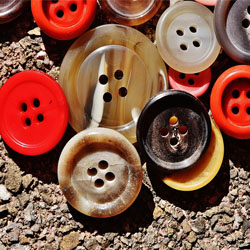 https://eduimg.auctiva.com/pushingbuttons55x55.jpg
https://eduimg.auctiva.com/pushingbuttons55x55.jpg
You've worked hard to bring together the best offering of goods to sell at your online site. You have enticing photos. You have compelling copy. So why can't you get your shoppers to do that one last thing: push the "Buy" button? Selling is of course a practice of persuasion, and it means that you have to be absolutely persuasive in every aspect of the act—and that includes the design and placement of your buttons. Here's what you need to know about that "Buy" button and what you can do to make it irresistible to your shoppers.
The persuasive palette…
Simply put, color matters—a lot! When it comes to business, color works to define a product, a service, or a brand on sight. When you see familiar colors in formation or combination, you can be instantly informed about what you’re seeing without needing to read a company name or discern a brand design. Think about the McDonald’s golden arches on the bold red background. Think about Barbie’s white script name emblazoned across a swath of pink. Think John Deere’s yellow deer on the green field. All these examples work to communicate brands and messages instantly… and persuasively.
But that’s branding—what about buttons? How can buttons—and, more to the point, their color—persuade online shoppers to take a preferred action? Again, colors matter. Colors embody mood, meaning, and exact an almost magical influence on each of us. Colors excite us. They assure us. They even command us. And when it comes to compelling your shoppers to push a button at your online store (or in your emails, blog entries, or wherever), color will make the difference in whether they’ll follow your lead or wander away.
Recent studies have concluded that up to 85% of shoppers identify color as a primary reason for making a purchase (and we’re not talking about a red dress here; we mean color used to incite an action). Color works as an indicator of what action to take. Think of any traffic signal—red tells you to stop, green tells you to go, and yellow tells you to either hurry up or slow down. Traffic signal colors have developed instinctive responses in us: our brains don’t need to think through their meanings. We see, we do. Equally, the placement of those colored signal lights tell us how to respond, whether the lights are stacked vertically or laid out horizontally. We see a color, we see its placement, and we respond accordingly. We’re persuaded, even commanded, to act or react. That’s the power of color use and color placement.
The Color Wheel, Revisited
So, with this whole color theory established, it’s time to consider some of the most-used colors in commerce and what they tend to communicate to and evoke from your customers:
- Yellow: If you’re thinking sunshine and lemon drops, you’re spot on. Yellow is proven to convey an optimistic and youthful outlook. It’s the color of potential and possibility, one that could convince your shoppers that pressing a yellow button will bring them an invigorating result.
- Red: While many associate red with dangers or warnings, in the commerce world it exudes energy, action, and urgency. It’s a color that physiologically increases heart rate and excites the retina. It is commanding in that it urges you take action NOW!
- Blue: Clear blue skies, crystal lakes, and cooling breezes—that’s what blue promises. It’s soothing, reassuring, and calming. When shoppers have concerns about safety, security, and sensible purchases, they respond positively to blue.
- Green: Sure, it’s the color of money and, therefore, it conveys notions of wealth and well-being. It’s also the color of inviting grassy hillsides and organic goodness that will make you feel better. It’s soothing and assuring (one reason so many hospital rooms are painted in a shade of green). It’s natural and communicates a sense of renewal.
- Orange: Most of us think of oranges and orange juice, a boost of natural energy, and a promise of good-for-you Vitamin C. Orange is regarded an assertive color. Not as demanding as red yet not as wistful as yellow, orange has been proven successful in calls to action, goading shoppers to click a button to buy, sell, or get more information.
- Pink: Easily the most feminine of the colors, pink sells to exactly who you might think it would: women and young girls. Nothing wrong with that and, in those target demographics, using a pink button could be exactly right.
- Black: No, it’s not a sign of dread or death. Today, black is sleek, elegant, and desirable. It imparts a sense of luxury, contrasting itself to any other colors (read: competitors) and promises the finer things in life.
Do you know your customer’ favorite color?
With all that you now know about colors and the reactions they evoke in us, it’s time to tailor their use in your overall business strategy when it comes to coloring your on-site buttons. Here are some top considerations for you:
- Choose the color wisely. Think of your products and your brand strategy. Who are your customers and how are you appealing to their wants, needs, and desires? Establish a button color that works with their thought process.
- Be practical when choosing the button size and shape. Consider that your site will mostly be viewed on a touch-enabled device. Be sure your buttons are touch-friendly, meaning they should be as wide as or wider than 48 pixels. Round the corners or create a symmetrically round button, as our subconscious tells us to avoid sharp edges.
- Place the buttons plainly: Yes, there is still a “fold” on digital displays and you still want to keep your actionable buttons above it. Use copy that make a quick and compelling draw, then place the button there. If you need to provide additional copy to convince the hesitant shopper, place a second button after that, below the fold.
Buttons matter and the color (and size, shape, and placement) of them can determine if your shoppers will commit to the purchase. Color their world in a way that suits them, then watch the clicks roll in!

Dennis L. Prince has been analyzing and advocating the e-commerce sector since 1996. He has published more than 12 books on the subject, including How to Sell Anything on eBay…and Make a Fortune, second edition (McGraw-Hill, 2006) and How to Make Money with MySpace (McGraw-Hill, 2008). His insight is actively sought within online, magazine, television and radio venues.
Opinions expressed here may not be shared by Auctiva Corp. and/or its principals.
Other Entries by this Author